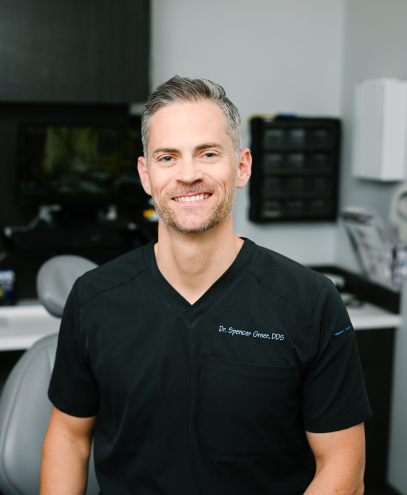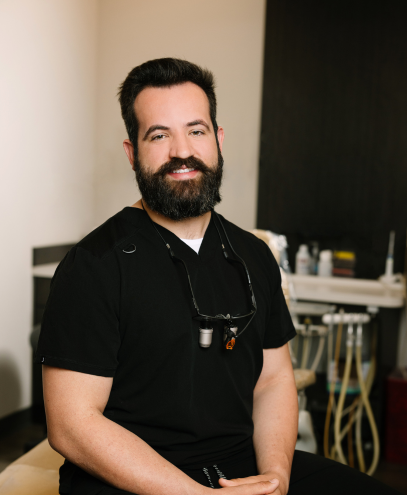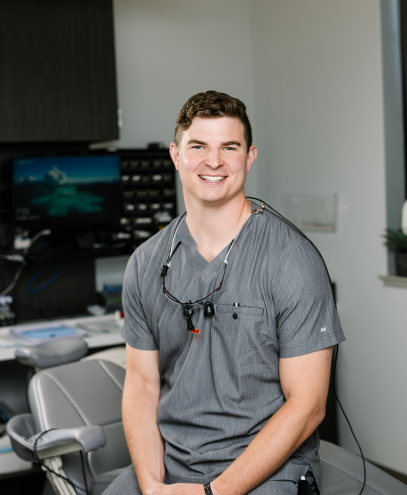Dental Implants
We offer the highest quality dental implant treatment in the Tri-Cities, WA area. Learn more about the process below and see if you’re a candidate today!
- Did You Know: Dental implants are the only dental restoration option that preserves natural bone, actually helping to stimulate bone growth.

What's a dental implant?
If you’ve never been a dental implant patient before, the concept and process can be confusing and foreign as implants are not what most people think of as day-to-day dentistry. However, implants quickly became the gold standard for tooth replacement after being introduced to dentistry in the early 1980s due to how versatile and predictable they are.
Dental implants are made of titanium, one of the most bio-compatible materials on the market, which means even if you have a metal allergy you are still likely to be an excellent candidate for implants. The implant is designed to function as the root of a tooth, meaning it is placed entirely in the jaw bone, just as your tooth’s natural root is. The top portion of the implant can be a single tooth, a part of a bridge helping to replace multiple teeth, or a component designed to improve a denture or partial denture.
Step 1:
Initial Consultation, Imaging, and determining eligibility.
The first step is simple, our team needs to determine if you are a good candidate for an implant. We’ll have you come in for a complimentary consultation to discuss what you’re searching for. Images will be taken with technology like our CBCT machine, and our dentists will take a close look to see if you’re a viable candidate to receive an implant.
If you are found to be eligible, step 2 goes over the typical surgical process for placing a titanium implant.

Step 2:
titamium Implant placement
Step 2 in the dental implant process is where we will place the titanium implant into your jawbone. A small drill will create room in your bone which is where the implant is inserted. The implant acts like a root of a natural tooth and will hold the crown on top, so ideal placement of the implant is crucial.
The implant is placed flush with your bone level and after several months, the implant will integrate with your bone.
This procedure is fast and you remain completely numb throughout. That being said, some patients still request some form of sedation dentistry to alleviate any possible anxiety.
Step 3:
Secure Your Crown & Abutment
Once the implant is integrated with your jaw, the final step is getting your crown affixed to the implant. An abutment (a small titanium piece) is screwed onto the implant and your dental crown gets secured to that.
Properly integrated dental implants can last your entire lifetime so it’s important that it’s done properly the first time. Come speak to our team and find out why we have over 2,400 5-star reviews on Google!
The Benefits of Dental Implants
Traditionally, if missing a tooth, the dentist would make a bridge. To fabricate a bridge, the neighboring tooth on either side of the space needs to be ground down to allow for a 3-unit bridge (3 crowns fused together that rest on the two teeth).
If the surrounding teeth did not need crowns then this process removes a major portion of healthy tooth unnecessarily. Bridges set those teeth up for difficulties in the future, such as need for a root canal, development of cavities in hard to fix areas (you can’t floss between the teeth when fused together), and fracture (we’re asking two teeth to do the work of three, and the supporting teeth have been whittled down).
Individual implants mimic a natural tooth better than any other option in dentistry. And unlike bridges, partials, or dentures, the strength of implant biting is often stronger than a natural tooth.
Although bridges have been successfully used in dentistry for hundreds of years, they generally shorten the lifespan of the teeth that support them and often need to be replaced multiple times over the years. Implants as we know them were introduced in the early 1980s, which means that our current research is only about 35 years old at this point. Over the last three decades implants have changed and improved greatly to be very predictable restorations. Because they are attached to a human body nothing can be guaranteed, but we anticipate implants that are well maintained will last many decades, and hopefully for life.
Without stimulation, our bone atrophies and shrinks away. When a tooth is removed, the bone that used to support that tooth will resorb over time, creating defects or dents, changes in face shape, and collapse of the cheeks and lips to make the patient appear older than they are.
When implants are placed, the forces from chewing are transmitted through the restoration into the bone. These forces stimulate the bone so that it maintains density and volume to support the implant, just as the bone surrounding natural teeth does. Also, our teeth prefer to have partners: if a tooth is removed, the opposing tooth will often grow out of the bone because there is no contact. Teeth will also tip or move forward into areas were teeth are missing which can alter and disrupt proper biting.
The most common image of a dental implant is one supporting a single crown, but they can be used in a variety of indications. Implants placed in multiples are able to support bridges to maximize the number of teeth replaced with a smaller number of implants.
When a patient has lost bone, four or more implants can be placed to support up to a full arch prosthesis that replaces teeth and the bone that used to support them.
Partial and complete denture patients benefit greatly from implants, as snaps can be placed on top of the implants instead of crowns and bridges. These snaps help the denture fasten in place and provide a major improvement in stability, comfort, chewing forces, and phonetics.
A set of complete dentures can only provide about 25% of the chewing forces that a mouth of healthy teeth can. By adding in just two implants at the lower canine positions, the patient improves to about 60% of their previous chewing ability. With every additional implant those forces increase, and the dentures can be designed to be smaller and less cumbersome which also improves taste, comfort, and aesthetics.
The top portion of the implant can be changed or updated throughout the patient’s life. If an implant was first placed to replace a single missing tooth, it can be swapped out to help support a bridge if nearby teeth are later extracted. If many or all of a patient’s teeth end up being removed, the crown or bridge can be changed to a snap to help support a partial or complete denture. This ability to modify an implant helps the patient to continue to benefit from the implant as they age and indications change.
In many offices, if you need an implant, you will be required to travel to outside offices for special x-rays, additional evaluations, the actual implant placement surgery, and multiple post-operative check-ups before you’re able to receive your restoration. The Mid-Columbia Dental team understands that our patients greatly prefer not having to go through that ordeal, and we’ve designed our practice so that we can provide every step of the implant process in our office. All of our doctors are very comfortable restoring implants.

“I’m in the process of getting implants in and the first step today was inserting the metal implant and I was absolutely terrified to get it done but Dr. Spencer was great and it went so smoothly! Thank you, guys!” – ROSE | VIA GOOGLE
Are You An implant Candidate?
Take our quick survey to see if dental implants are right for you!


Specialized Dentistry
Bone Grafting: What is it and why is it important?
The impact of tooth loss extends far beyond the visible gap in your smile. When a tooth is lost, the surrounding bone no longer serves its original purpose and begins a process known as resorption, gradually shrinking in size and density. This phenomenon can lead to various oral health issues and aesthetic concerns, such as sunken facial features and difficulty in chewing.
Fortunately, modern dentistry offers a solution to this through a procedure called bone grafting. Bone grafting is a highly effective technique used to regenerate and rebuild lost jawbone tissue. By using a variety of bone graft materials, including ground bone from donor sources or synthetic alternatives, dentists can stimulate the growth of new bone in areas where it has been lost.
Dental Implant Procedures For All Conditions and Budgets!
Dental Implants Can Restore What’s Been Missing In Life: Confidence, Comfort, & A Natural-Looking Smile!
Dental Implants are becoming more common and can replace most missing teeth. At Mid-Columbia Dental, we will work with you to claim your insurance benefits and work within your budget. To find out if they will work for you, schedule your consultation today at (509) 497-7777!

Services We Offer
Meet Our Dentists

Dr. Spencer Greer
General Dentist and Owner of Mid-Columbia Dental
Dr. Greer is from Mesa, Arizona and attended Brigham Young University and Creighton University School of Dentistry.
“Initially, I was on a different career path when I felt a strong calling to do something with my hands in the sciences. Shortly thereafter, I had my yearly dental exam; that’s when I knew that being a dentist was what I was called to do. It’s been beyond rewarding to feel needed, challenged and successful. I couldn’t do what I do without my amazing team.”
When Dr. Greer isn’t being a Rockstar dentist or serenading his patients with song, he can be found alongside his wife and five kiddos. He enjoys mountain biking, surfing, playing pickleball with his wife and sons, and enjoying family performances where everyone takes a turn in the spotlight.

Dr. Nick Howard
General Dentist
Nick is from Bellevue, Washington and studied dentistry at Roseman University of Health Sciences. His natural curiosity for science and being drawn to people made it easy for his wife to see that he would make a great dentist.
“I’m so grateful to her for opening this door because I love dentistry, every facet of it intrigues me.”
When Nick isn’t providing stellar care to his patients, he likes to spend his spare time with his beautiful wife and three kiddos.
“Family is most important to me, and I would be honored to help you and your family with all your dentistry needs!”

Dr. Garrett Stoker
General Dentist
Dr. Stoker is from West Richland, Washington and graduated from the University of Washington. He began his journey into dentistry as a Dental Assistant, where he discovered the joy and satisfaction of being part of a patient’s oral health transformation. Having a big heart for serving others and helping with community outreach programs also made becoming a Dentist an easy choice.
“Dentistry allows me to balance family life while still helping the community, which lines up with my core values.”
In his free time, Dr. Stoker enjoys competitively playing board games with his wife, performing hip-hop dance parties with his kiddos, and enjoying the outdoors with his family.
Hear from Our Patients!
5-Star rated dentist with over 2,400 reviews on Google!




Schedule Your Next Dentist Visit!
Convenient Locations in Pasco and Kennewick
Kennewick Location
Mon: 8am – 5pm
Tues: 8am – 5pm
Wed: 8am – 5pm
Thurs: 7am – 3pm
Fri: Closed
Sat: Closed
Sun: Closed
Pasco Location
Mon: 8am – 5pm
Tues: 8am – 5pm
Wed: 8am – 5pm
Thurs: 8am – 5pm
Fri: 8am – 5pm
Sat: Closed
Sun: Closed





